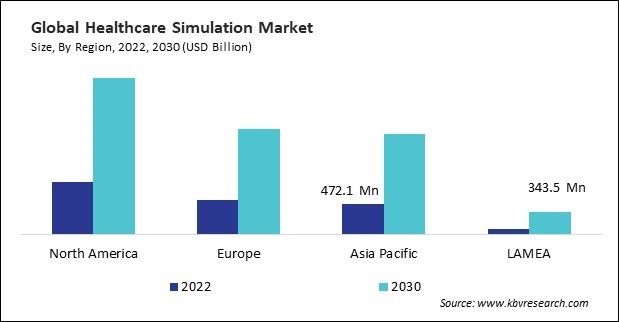According to a new report, published by KBV research, The Global Healthcare Simulation Market size is expected to reach $6.0 billion by 2030, rising at a market growth of 15.5% CAGR during the forecast period.
Simulation facilitates interprofessional education initiatives by bringing together learners from different healthcare disciplines to collaborate on patient care scenarios. These experiences promote teamwork, mutual respect, and interdisciplinary collaboration, essential skills for delivering patient-centered care in today’s healthcare environment. Interprofessional simulation scenarios may involve team-based assessments, collaborative care planning, and joint decision-making exercises, fostering a culture of collaboration and cooperation among healthcare professionals.

Standardized patient (SP) programs evolve to incorporate new technologies, methodologies, and simulation modalities. Virtual SPs, telemedicine simulations, and hybrid simulation models complement traditional SP-based scenarios, offering new opportunities for authenticity, scalability, and diversity in simulation-based education. SP programs emphasize realistic patient interactions, communication skills development, and empathy training, preparing learners for the complexities of clinical practice. Furthermore, serious games and gamified simulation platforms engage learners through interactive gameplay, storytelling, and scenario-based challenges.
The Virtual Patient Simulation segment would exhibit a CAGR of 16% during (2023 - 2030). Virtual patient simulation offers accessible and scalable training solutions that can be accessed anytime, anywhere, with minimal equipment requirements. Learners can engage in simulation-based training activities remotely using web-based platforms or desktop applications, eliminating the need for physical simulation labs or specialized equipment.
The Academic Institutes segment is generating highest revenue in the Global Healthcare Simulation Market by End-use in 2022; thereby, achieving a market value of $2.4 billion by 2030. Academic institutes recognize the value of experiential learning in healthcare education. Through realistic, hands-on experiences, simulation helps students close the gap between theory and clinical practice. Through participation in simulated clinical settings, students gain clinical competencies, decision-making skills, and critical thinking abilities in a secure setting.
The Healthcare Anatomical Models segment is experiencing a CAGR of 14.9 % during (2023 - 2030). Anatomical models offer a highly realistic replication of human anatomy, allowing healthcare professionals to practice various medical procedures and interventions in a simulated environment. These models closely mimic the structure and texture of human tissues, organs, and body systems, providing learners with a hands-on experience that closely resembles real clinical scenarios.
Full Report: https://www.kbvresearch.com/healthcare-simulation-market/
The North America region dominated the Global Healthcare Simulation Market by Region in 2022, and would continue to be a dominant market till 2030; thereby, achieving a market value of $2.4 billion by 2030. The Europe region is anticipated to grow at a CAGR of 15% during (2023 - 2030). Additionally, The Asia Pacific region would witness a CAGR of 16.4% during (2023 - 2030).
By Technology
By End-use
By Product & Services
By Geography
 Unique Offerings
Unique Offerings